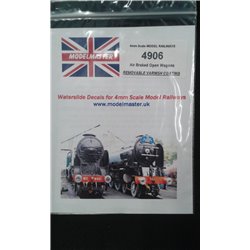There are tens of thousands of decals available covering a multitude of different models from trains, planes and...
No products
Product successfully added to your shopping cart
There are 0 items in your cart. There is 1 item in your cart.
Search Tips
What is the British Rail TOPS system?
The TOPS system (Total Operations Processing System) is a computerised system used to keep track of a locomotive/rolling stock's location and servicing requirements. TOPS was developed in America to enable the railways to track their rolling stock remotely and not rely on centrally stored information recorded on paper. The system was adopted here in the UK in the mid-1960s in an attempt by British Rail to become more efficient.
Implementation of TOPS resulted in all of British Rail's locomotives being renumbered to a format that the computer system could cope with. The new five-digit locomotive numbers consisted of a two-digit class number followed by a unique three-digit engine identification number.
In an effort to group locomotives types, diesels were given class numbers between 01-69, DC electrics (including dual diesel/DC electrics) between 70-79, AC electrics between 80-96, departmental locos were given the classification 97 and steam engines 98. This continued into the multiple units with DMUs being allocated classes between 100-299, AC EMUs between 300-399 (including dual AC/DC EMUs) and DC EMUs allocated classes between 400-499. The trend for grouping types of traction in this way continued into modern times with classes in the 700s being represented by new electric and bi-mode units and classes in the 800s consisting of high-speed trains.
The TOPS class system worked well when it was introduced, but as operational requirements developed, so did the requirement to upgrade, modernise or enhance small numbers of locomotives within a class, for example, by fitting them with electric train heating or uprating their power output. To make these enhancements clearly visible on the system, special engines were grouped into sub-classes, for example, Class 47/4.
The TOPS system has served well for over half a century, but as technology continuously develops, the text-based system is beginning to show its age and a replacement is undoubtedly just around the corner.
Click here to receive the tips weekly in your mailbox. You can unsubscribe at any time.








